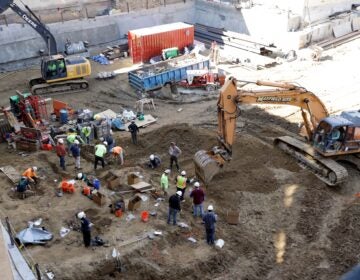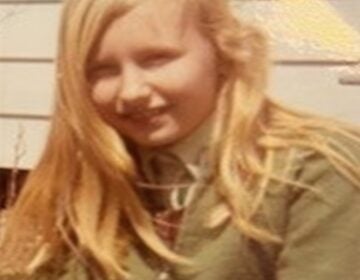Some 18th and 19th century Philadelphians have been buried again — this time with descendants telling their stories
Eight years ago, construction workers discovered centuries-old human remains in Old City. Recently, descendants and researchers commemorated the reburial.
Listen 5:40
Jennifer O'Donnell of the Friends of Mount Moriah Cemetery lays a bouquet at the reburial site for the remains of nearly 500 people unearthed from a former burial in Old City, Philadelphia. (Emma Lee/WHYY)
From Philly and the Pa. suburbs to South Jersey and Delaware, what would you like WHYY News to cover? Let us know!
On a windy Saturday afternoon in November, people came to Philadelphia from as far away as Montana, California, and Florida to celebrate their ancestors, whose remains were found at a construction site eight years ago.
The ceremony at Mount Moriah Cemetery in southwest Philadelphia on Nov. 23 marked the end of a long process of recovering, protecting, studying and identifying the human remains. It’s also the start of more research, which could lead to better scientific tools and a better understanding of what life in Philadelphia was like centuries ago.
Kimberlee Moran, a forensic archaeologist at Rutgers University-Camden, helped organize the recovery and research effort, as well as the ceremony.
“The discovery of these remains has offered us an extraordinary opportunity, a chance to listen to the stories that archaeology, science and faith have brought together into the present,” she said to a small group of descendants, researchers and church members at the ceremony.
This began in the 18th century, when the First Baptist Church of Philadelphia was supposed to move their cemetery from Arch Street to Mount Moriah Cemetery.
“They had three months in the middle of winter with 1860s technology to try to dig up thousands of people and relocate them,” Moran explained earlier this year. “Essentially they just did … the best they could with the time that they had and called it a day.”

Some of the human remains were left behind, until construction workers laying the foundation for an apartment building found them in 2016 — more than 150 years later.
Moran and a group of researchers recovered the remains, documented the findings, prevented further damage and did the detective work to find out who the people were.
One of them was Benjamin Britton, an 18th century craftsman and baker who lived through the American Revolutionary War and signed an oath of allegiance to the newly formed United States of America in 1777. Britton was married twice, raised a blended family, owned farmland and slaves, and lived through unpredictable crop yields, inflation and social unrest, recalled Kathy Hartmann, who came from California to Philadelphia for the ceremony. Britton was her sixth great-grandfather.
“Family history is one of my passions and sharing the stories of our ancestors with my brothers, my children and my grandchildren and anyone else who’ll listen brings me great pleasure and satisfaction,” Hartmann told the crowd. “It’s my hope that in sharing a few details of Benjamin Britton’s life with you, we find a sense of kinship and connection and humanity to all those we honor today. Although we are separated from them by many years, we share the familiar challenges of everyday life, seeking to provide for our families and make our own place in the world.”
Hartmann kept in touch with Moran and the researchers over the years. After the ceremony, she said it meant a lot to her to know that so many people worked for so long to respectfully uncover the story of Britton and the other people who were buried at the Arch Street site.
“All of these volunteers and employees of … the various academic institutions became so invested in the lives of these people,” she said. “I was very touched by what was obviously the camaraderie and the investment in … my ancestor.”

Some of the researchers spoke about the work it took to recover and reconstruct what they found at the site, to learn about the people buried there.
Biological anthropologist Claire Gold recalled that when she volunteered at the site in March 2017, it was freezing cold and raining most of the time.
“It was tough conditions to work in,” Gold said. “But it didn’t matter because I knew, like, my fellow volunteers, that whoever these people were, they certainly didn’t deserve to end up in a landfill, which is what might have happened.”
It took years of research, coordination with the property developer, and even a court case over who is in charge of a historic cemetery that is now on private property.
Moran said the research will help historians learn more about what Philadelphia was like centuries ago.
“This cemetery is really the largest systematic study of … people from pre-colonial times all the way to the cusp of the American Civil War.”
This marks an end to the long saga of the remains discovered at Arch Street. But Moran said this is just the start of the research journey.
“Now that the remains are reburied, we’re now pivoting to data analysis,” Moran said. ”We’ve collected all this information. What does it actually mean? What are the different strands that can be connected across the different studies?”
She said the work has already led to scientific progress, like developing better tools to get genetic information out of bones, which was previously hard to do.
“Bone is a really tricky matrix for getting good DNA profiles because essentially bone is just rock. All of the organic stuff has more or less decomposed away,” she said.
Moran and the researchers involved already have multiple scientific papers in progress.
“The knowledge that’s generated and the results that are generated are hopefully going to contribute to many future studies for our overall history and understanding of the city of Philadelphia and its residents,” Moran said.
She said it could take several more years for researchers to learn all that they can about this site and the people who were buried there.

Get daily updates from WHYY News!
WHYY is your source for fact-based, in-depth journalism and information. As a nonprofit organization, we rely on financial support from readers like you. Please give today.













